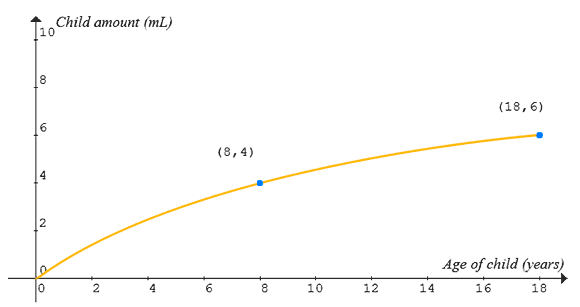Evaluating formulas
Solution to question 1 continued
The formula could be written as
| Child amount | = Adult amount × \(\dfrac{\text{Age of child}}{\text{Age of child}\,+\,12}\) |
| = 10 × \(\dfrac{8}{8+12}\) | |
| = 10 × \(\dfrac{8}{20}\) | |
| = 10 × \(\dfrac{2}{5}\) | |
| = 4 mL. |
\(\dfrac{2}{5}\) = 0.4 can be considered as a proportion. This increases as the age of the child increases. Notice that the formula suggests that an 18-year-old should get 6 mL but an 18-year-old is an adult. These results are summarised in the table and graph below.
Table 1. The results for an adult amount of 10 mL
| Age of child (years) |
Proportion | Adult amount (mL) |
Child amount (mL) |
|---|---|---|---|
| 4 | 0.25 | 10 | 2.5 |
| 6 | \(0.\dot{3}\) | 10 | \(3.\dot{3}\) |
| 8 | 0.4 | 10 | 4 |
| 12 | 0.5 | 10 | 5 |
| 18 | 0.6 | 10 | 6 |
Child amount (mL) against Age of child (years) for an adult amount of 10 mL

Detailed description of graph
© Australian Mathematical Sciences Institute, except where indicated otherwise. This material is licensed under a Creative Commons Attribution-NonCommercial 3.0 Unported (CC BY-NC 3.0) licence http://creativecommons.org/licenses/by-nc/3.0/
![]()